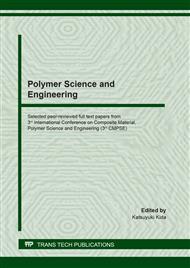[1]
J. Na, W. Mu, G. Qin, W. Tan, and L. Pu, Effect of temperature on the mechanical properties of adhesively bonded basalt FRP-aluminum alloy joints in the automotive industry, Int. J. Adhesion and adhesives. 85 (2018) 138-148.
DOI: 10.1016/j.ijadhadh.2018.05.027
Google Scholar
[2]
R. Avendaño, R.J.C. Carbas, E.A.S. Marques, L. F. M. da Silva, and A. A. Fernandes, Effect of temperature and strain rate on single lap joints with dissimilar lightweight adherends bonded with an acrylic adhesive, Compos. Struct. 152, (2016) 34-44.
DOI: 10.1016/j.compstruct.2016.05.034
Google Scholar
[3]
J. Zhang, X. Cheng, X. Guo, J. Bao, and W. Huang, Effect of environment conditions on adhesive properties and material selection in composite bonded joints, Int. J. Adhesion and adhesives, (2018) 1-28.
DOI: 10.1016/j.ijadhadh.2018.12.001
Google Scholar
[4]
N.S. Reddy, U.K. Jinaga, B.R. Charuku, P.K. Penumakala, and A. V. S. S. Prasad, Failure analysis of AA8011-pultruded GFRP adhesively bonded similar and dissimilar joints, Int. J. Adhesion and adhesives, 90 (2019) 97-105.
DOI: 10.1016/j.ijadhadh.2019.02.004
Google Scholar
[5]
F.A. Stuparu, D.A. Apostol, D.M. Constantinescu, C.R. Picu, M. Sandu, and S. Sorohan, Local evaluation of adhesive failure in similar and dissimilar single-lap joints, Eng. Fract. Mech., 183 (2017) 39-52.
DOI: 10.1016/j.engfracmech.2017.05.029
Google Scholar
[6]
K. Gültekin, S. Akpinar, and A. Özel, The effect of the adherend width on the strength of adhesively bonded single-lap joint: Experimental and numerical analysis, Compos. Part B, 60 (2014) 736-745.
DOI: 10.1016/j.compositesb.2014.01.022
Google Scholar
[7]
A. Ozel, B. Yazici, S. Akpinar, M.D. Aydin, and Ş. Temiz, A study on the strength of adhesively bonded joints with different adherends, Compos. Part B, 62 (2014) 167-174.
DOI: 10.1016/j.compositesb.2014.03.001
Google Scholar
[8]
K. Machalická and M. Eliášová, "Adhesive joints in glass structures: effects of various materials in the connection, thickness of the adhesive layer, and ageing, Int. J. Adhes. Adhes., 72 (2017) 10-22.
DOI: 10.1016/j.ijadhadh.2016.09.007
Google Scholar
[9]
G. Yang, T. Yang, W. Yuan, and Y. Du, The influence of surface treatment on the tensile properties of carbon fiber-reinforced epoxy composites-bonded joints, Compos. Part B Eng., 160 (2019) 446-456.
DOI: 10.1016/j.compositesb.2018.12.095
Google Scholar
[10]
F. Heidarpour, M. Farahani, and P. Ghabezi, Experimental investigation of the effects of adhesive defects on the single lap joint strength, Int. J. Adhes. Adhes., 80 (2018) 128-132.
DOI: 10.1016/j.ijadhadh.2017.08.005
Google Scholar
[11]
E.M. Moya-Sanz, I. Ivañez, and S.K. Garcia-Castillo, Effect of the geometry in the strength of single-lap adhesive joints of composite laminates under uniaxial tensile load, Int. J. Adhes.Adhes., 72 (2017) 23-29.
DOI: 10.1016/j.ijadhadh.2016.10.009
Google Scholar
[12]
M. Ashrafi, A. Ajdari, N. Rahbar, J. Papadopoulos, H. Nayeb-Hashemi, and A. Vaziri, Adhesively bonded single lap joints with non-flat interfaces, Int. J. Adhesion and Adhesives, 32 (2012) 46-52.
DOI: 10.1016/j.ijadhadh.2011.09.004
Google Scholar
[13]
S. Budhe, M.D. Banea, S. de Barros, and L.F.M. da Silva, An updated review of adhesively bonded joints in composite materials, Int. J. Adhes. Adhes., 72 (2017) 30-42.
DOI: 10.1016/j.ijadhadh.2016.10.010
Google Scholar
[14]
ASTM D1002, Standard Test Method for Apparent Shear Strength of Single-Lap-Joint Adhesively Bonded Metal Specimens by Tension Loading.," West Conshohocken, PA ASTM Int., (2010).
DOI: 10.1520/d1002-10
Google Scholar


